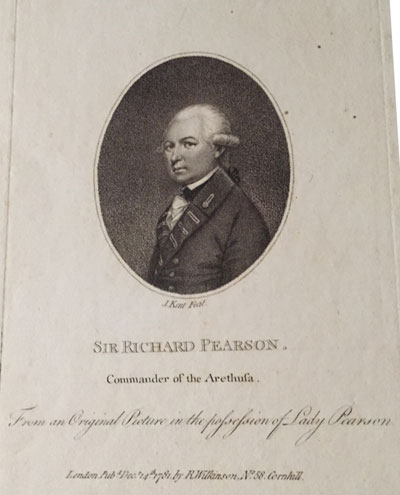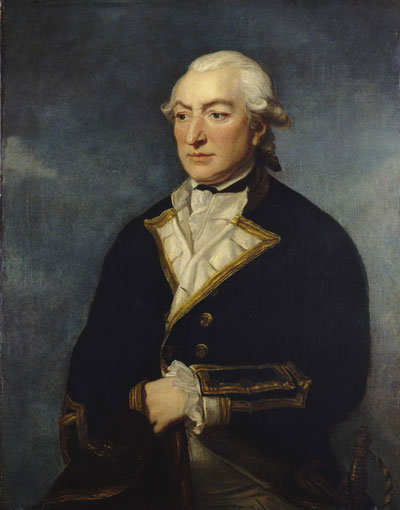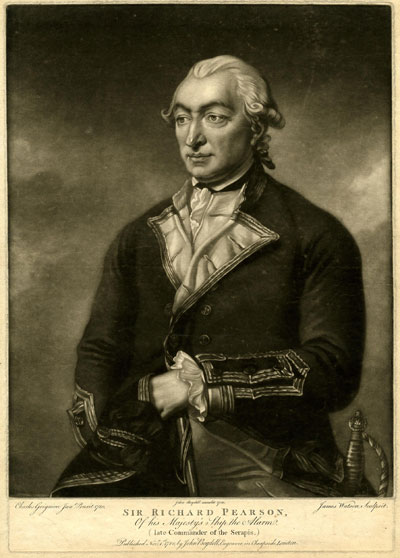Sir Richard Pearson
This is one of approximately ten "serious" prints created by Gillray in 1781 (including portraits and sentimental prints) using the alias "J.Kent" or just "Kent." And it was just one of several efforts by Gillray in the 1780s to get himself recognized as an artist/engraver apart from his work as a graphic satirist. Indeed I suspect that he may have felt that the use of an alias was necessary to prevent potentially "serious" employers from being scared off by his sometimes crude satiric work; and vice versa, that his satiric opportunities would be limited if his name were too closely associated with sentimental furniture prints.

© Banjamin Lemer Private Collection
Photo by Jim Sherry
The immediate impetus for this print was probably the following notice, which appeared in at least three different newspapers in June of 1781.
The Lords of the Admiralty have put his Majesty's new frigate Arethusa, of 40 guns, now at Bristol, into commission; the command of which is given to Sir Richard Pearson, late of the Serapis, which had the engagement with Paul Jones, and she is fitting out for sea.
London Chronicle June 16, 1781, p. 6.
But Captain Richard Pearson's primary claim to fame (alluded to in the London Chronicle report) occurred two years before this print at the Battle of Flamborough Head, when Pearson met with a squadron of five Franco-American ships led by the (in)famous American Naval Commander, John Paul Jones.
On September 23 1779, as Pearson in the 44-gun Serapis was leading a convoy of some 40 merchant ships carrying wood and iron from the Baltic bound for ports in the south of England, the American squadron was sighted. Pearson warned the other members of the convoy and positioned the Serapis and the Countess of Scarborough under Captain Thomas Piercy between the Franco-American squadron and the British convoy. In the ensuing battle, Pearson and Piercy successfully held off the attacking Americans until all the members of the convoy had escaped. And though the significantly outnumbered British ships were ultimately captured, Jones's flagship the Bonhomme Richard was sunk and abandoned, forcing Jones to return to his home base in Pearson's captured Serapis.
For his "gallant and brave conduct" Pearson received thanks and gifts from merchants whose materials were saved and the freedom of port towns where those materials successfully arrived. But the crowning recognition came in April of 1780, when he was knighted at a ceremony at St. James's Palace, thereby becoming "Sir Richard." A portrait of Pearson in in full naval dress uniform by Charles Grignion followed a few months later, and was displayed as part of the Royal Academy's Summer Exhibition in June of 1780.

Sir Richard Pearson
[~June 1780]
© Wikipedia
The mezzotint by James Watson, published by Boydell in November of 1780 is clearly based upon the Grignion portrait.

Sir Richard Pearson
[November 1, 1780]
© Wikipedia
But it is just as clear that the Gillray/Kent portrait is not. If we take Gillray at his word, this print was taken from a completely different source: "From an Original Picture in the Possession of Lady Pearson." There are, however, several puzzling things about this note. One is that the word "Picture" is generic; it could describe a painting, a drawing, or another print. Second, there is no attribution, no indication of who created the original picture. In cases like this, it was common practice to identify the creator of the source either in the subtitle (e.g. After a Painting by XYZ) or in the signature line, "del XYZ." This print has neither. But even allowing that Gillray may have wanted to hide the source, one would think that another picture of Pearson from that time would have appeared by now in the British Museum, National Portrait Gallerty or the National Maritime Museum. There is no such picture. Once again, this is puzzling. Finally, how would Gillray have gotten access to this picture in Lady Pearson's possession?
Given the utterly vague and yet carefully worded title my own guess is that Gillray worked from his own sketch, and (to preserve the accuracy of the note) gave the sketch to Lady Pearson. His publisher, in this case Robert Wilkinson, was a high-end map maker as well as a print seller. Up-to-date and accurate maps were essential to all military officers, so Gillray could have become acquainted with Pearson and his wife through Wilkinson and his shop. Wilkinson seems not to have been shy about pursuing high-end customers. A few years later in 1784, Wilkinson dedicated two prints by Gillray to the heiress Henrietta Gertrude Hotham (1753-1816), the only child of the Baronet Sir Charles Hotham and his wife Lady Dorothy Hobart.
Sources and Reading
- "Richard Pearson (Royal Navy officer)," Wikipedia
- "John Paul Jones," Wikipedia
- "Battle of Flamborough Head," Wikipedia
Comments & Corrections
NOTE: Comments and/or corrections are always appreciated. To make that easier, I have included a form below that you can use. I promise never to share any of the info provided without your express permission.